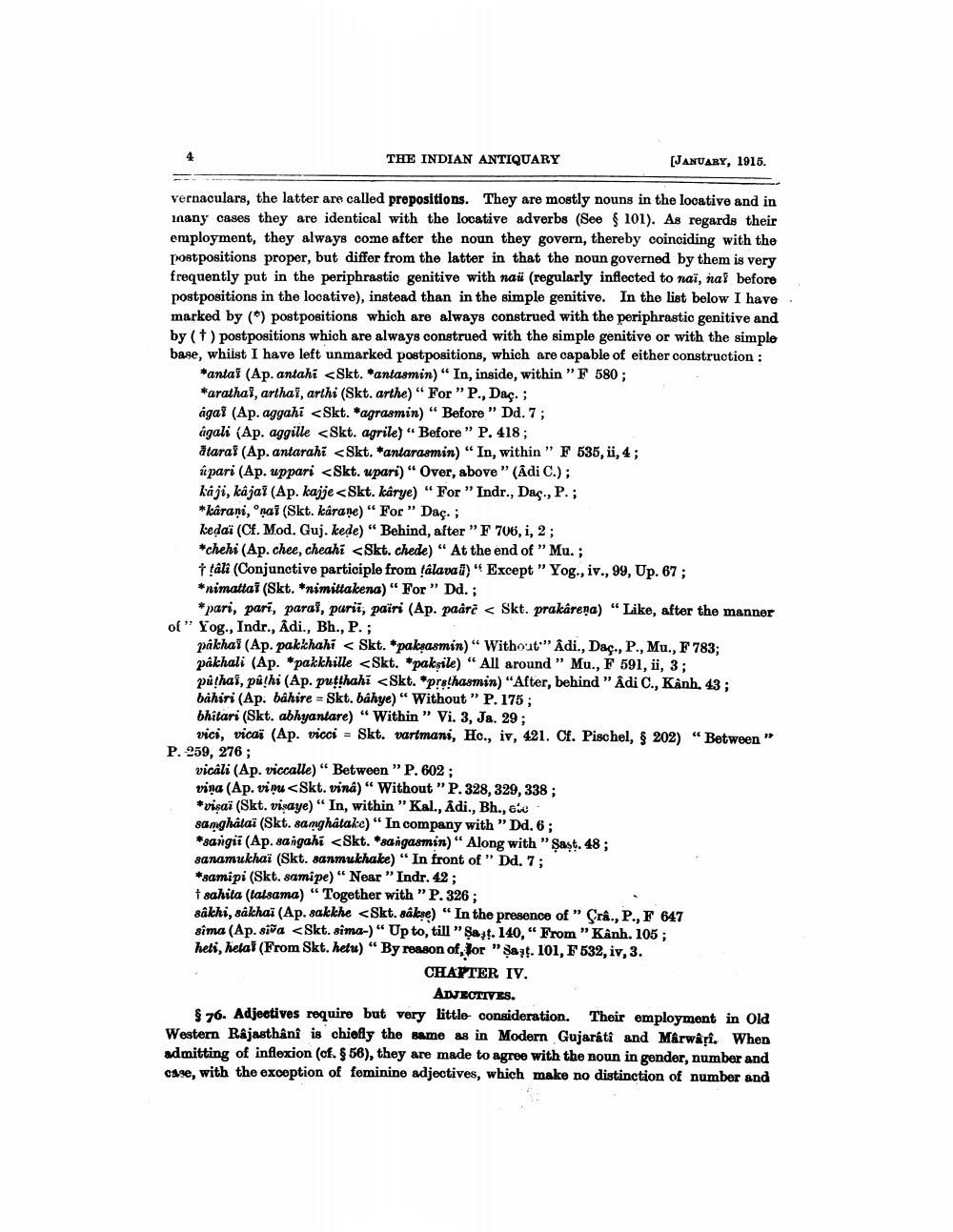________________
THE INDIAN ANTIQUARY
[JANUARY, 1915.
vernaculars, the latter are called prepositions. They are mostly nouns in the locative and in inany cases they are identical with the locative adverbs (See $ 101). As regards their employment, they always come after the noun they govern, thereby coinciding with the postpositions proper, but differ from the latter in that the noun governed by them is very frequently put in the periphrastic genitive with nai (regularly inflected to naï, nal before postpositions in the locative), instead than in the simple genitive. In the list below I have marked by (5) postpositions which are always construed with the periphrastic genitive and by (+) postpositions which are always construed with the simple genitive or with the simple base, whilst I have left unmarked postpositions, which are capable of either construction :
*antal (Ap. antahi <Skt. *antasmin)" In, inside, within "F 580; *arathai, arthai, arthi (Skt. arthe) "For "P., Dac.; agal (Ap. aggahi <Skt. *agrasmin) " Before " Dd. 7; ágali (Ap. aggille <Skt. agrile) " Before " P. 418; ataral (Ap. antarahi <Skt. *antarasmin) “In, within " F 535, ii, 4; á pari (Ap. uppari <Skt. upari) “ Over, above" (Adi C.): kaji, kajai (Ap. kajje <Skt. karye) "For "Indr., Daç., P.; *karani, nai (Skt. kârane) “For ” Dac.; kedai (Cf. Mod. Guj. kede) "Behind, after ”F 706, i, 2; *chehi (Ap. chee, cheahi Skt. chede) “At the end of " Mu.;
lali (Conjunctive participle from talavai) " Except " Yog., iv., 99, Up. 67; *nimattai (Skt. *nimittakena)" For " Dd.;
*pari, pari, paral, purü, païri (Ap. paarë < Skt. prakarena) "Like, after the manner of " Yog., Indr., Adi., Bh., P.;
påkhai (Ap. pak chahi < Skt. *paksasmin)“ Without." Adi., Daç., P., Mu., F 783; pakhali (Ap. *pakkhille <Skt. *paksile) "All around " Mu., F 591, ï, 3; púthai, pû!hi (Ap. putthahi <Skt. prathasmin) "After, behind "Âdi C., Kảnh. 43; bahiri (Ap. bâhire - Skt. báhye)" Without " P. 175; bhitari (Skt. abhyantare) “Within ” Vi. 3, Ja. 29;
vici, vicaj (Ap. vicci - Skt. vartmani, Hc., iv, 421. Cf. Pischel, $ 202) “Between" P. 259, 276;
vicâli (Ap. viccalle)" Between "P. 602 ; vina (Ap. vimu <Skt. vina)“ Without "P.328, 329, 338 ; *vişaï (Skt. visaye)" In, within "Kal., Adi., Bh., eu samghataï (Skt. samghatake)" In company with " Dd. 6; *sangii (Ap. saigahi <Skt. *sangasmin) "Along with "Şast. 48; sanamukhaï (Skt. sanmukhake) "In front of " Dd. 7; *samipi (Skt. samipe) “Near "Indr. 42; tsahita (talsama) “ Together with "P.326; sâkhi, sakhai (Ap. sakkhe <Skt. sakse) "In the presence of " Sra., P., F 647 sima (Ap.siña <Skt. sima-) “ Upto, till ”Şazt. 140,"From "Kanh. 105; heti, helal (From Skt. hetu) “By reason of, Jor "Sazt. 101, F 532, iv, 3.
CHAPTER IV.
ADJECTIVES. $76. Adjectives require but very little consideration. Their employment in Old Western Rajasthânî is chiefly the same as in Modern Gujarati and M&rwâți. When admitting of inflexion (cf. 856), they are made to agree with the noun in gender, number and case, with the exception of fominino adjectives, which make no distinction of number and




